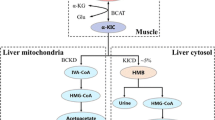Abstract
Vitamin A derivatives (retinoids) play a key role in mammalian development and cell differentiation. Isomers of retinoic acid, the main active metabolite of vitamin A, activate retinoid receptors that act as ligand-dependent transcription factors and affect gene expression. White and brown adipose tissues are major sites of storage of vitamin A derivatives and they play an active role in whole body metabolism of retinoids. Moreover, adipose tissues are targets for the action of retinoic acid. In most cases retinoic acid impairs adipocyte differentiation although its final effects on adipose tissue development depend on retinoic acid concentration, isomers availability andexpression of retinoid receptor subtypes in the white or brown adipocyte. Retinoic acid (RA) has a specific effect on brown adipose tissue, because it activates transcription of the gene for uncoupling protein-1, responsible for brown fat thermogenesis.
Similar content being viewed by others
Author information
Authors and Affiliations
Rights and permissions
About this article
Cite this article
Villarroya, F., Giralt, M. & Iglesias, R. Retinoids and adipose tissues: metabolism, cell differentiation and gene expression. Int J Obes 23, 1–6 (1999). https://doi.org/10.1038/sj.ijo.0800799
Received:
Revised:
Accepted:
Published:
Issue Date:
DOI: https://doi.org/10.1038/sj.ijo.0800799
- Springer Nature Limited
Keywords
This article is cited by
-
Early exposure to social disadvantages and later life body mass index beyond genetic predisposition in three generations of Finnish birth cohorts
BMC Public Health (2020)
-
Childhood overweight in Berlin: intra-urban differences and underlying influencing factors
International Journal of Health Geographics (2016)
-
Retinoic acid has different effects on UCP1 expression in mouse and human adipocytes
BMC Cell Biology (2013)
-
Toddler self-regulation skills predict risk for pediatric obesity
International Journal of Obesity (2010)
-
RARγ and TRβ expressions are decreased in PBMC and SWAT of obese subjects in weight gain
Journal of Physiology and Biochemistry (2010)




